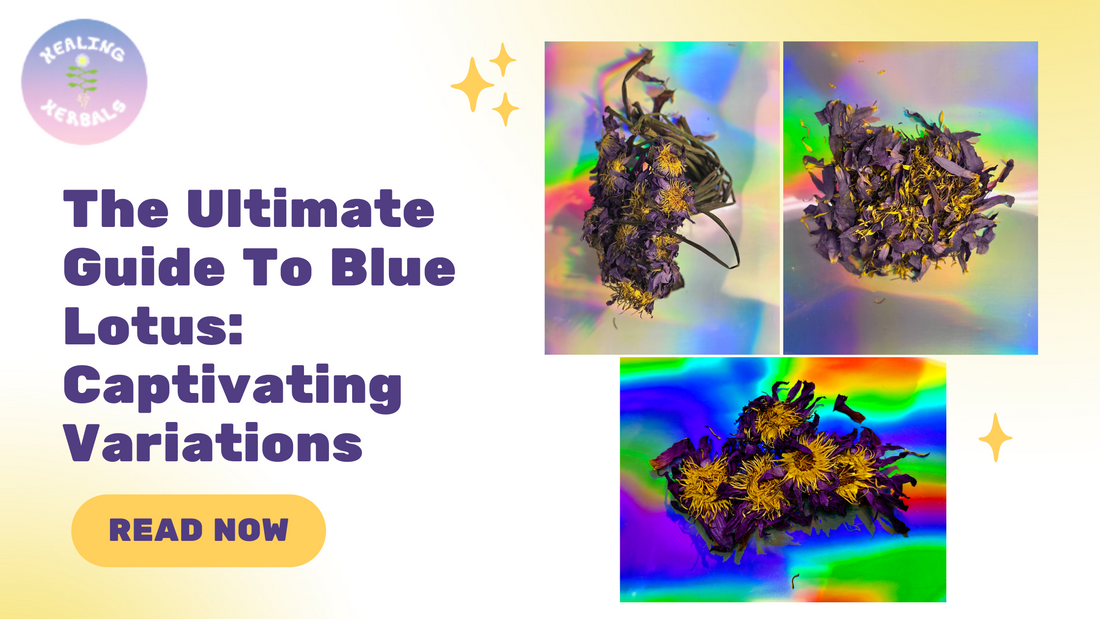
The Ultimate Guide To Blue Lotus: Captivating Variations
Share
Blue Lotus (Nymphaea caerulea) has captivated humans for centuries. From Egyptian ceremonies to modern herbalists, the lovely water lily has forever existed in an aura of mystery and sophistication. If you have shopped around in botanical shops like Healing Herbals, then you've probably noticed that Blue Lotus does not actually come in one single format. Instead, you'll have choices like Blue Lotus with stems, Blue Lotus petals and stamens, stamens alone, and whole flowers.

They all appear to be the same at a glance, but they are all different in their own right. Knowing the differences will enable you to select the variety that would be most suitable for you.
This is the most complete and down-to-earth choice. It includes not just the beautiful petals and stamens, but the stems themselves. Because stems occupy space, this form is generally the least expensive. The compromise is that it's not as delicate as the flower-only forms, but it has a down-to-earth character that some like.

- Recommended for: Anyone seeking an affordable, all-purpose type of Blue Lotus.
- What it looks like: Blended petals and stamens with elongated, greenish stalks.
- Why choose it: A good balance, every day value that gives you more quantity for money.
2. Blue Lotus Petals & Stamens
This is the traditional variety most individuals envision when they hear of Blue Lotus. The delicate, blue-violet petals are mixed with the golden stamens, making both a stunning and harmonious product. It provides the optimal combination of delicate looks with substance and depth.

- Best for: People who prefer the traditional Blue Lotus experience.
- What it is: A stunning mixture of golden threads and multicoloured flowers.
- Why select it: Achieves a natural balance neither too earthy nor too dainty.
3. Blue Lotus Stamens Only
Stamens are the fine, thread-like pollen bearers of the flower. When pulled away from the petals, they are lighter, more dense, and in other instances, reported to be the "refined" aspect of the plant. As they are less bulky, they tend to be used for more precise applications.
- Perfect for: Those who like a lighter, stronger variant of Blue Lotus.
- What it looks like: Thin, golden strands airy and fragrant.
- Why use it: Offers a clean, neat solution without the unnecessary bulk of petals or stems
This is the showstopper. Dried whole Blue Lotus flowers preserve the natural beauty of the plant. With whole flowers, this variety has a particular feel, sort of ceremonial, and is often selected due to its beauty and its quality.

- Best for: Those seeking the most refined, best-looking solution.
- What it looks like: Full blooms with petals and stamens intact stunning and graceful.
Thus, Which One to Choose
It really does boil down to what you are looking for:
- Want something handy and cost-effective? Try Blue Lotus with stems.
- Want the balanced, classic one? Make use of petals and stamens.
- Something light and dainty, perhaps? Only stamens would be the choice.
- Looking for beauty and presentation? You can't do better than whole flowers.
- Something light and dainty, perhaps? Only stamens would be the choice.
- Looking for beauty and presentation? You can't do better than whole flowers.
Each one has its own personality, and part of the enjoyment is attempting to discover which shape you relate to most.
Where to Find True Blue Lotus
All Blue Lotus is not equal, so it's worth while to purchase it from a good source. Healing Herbals stocks all four forms stems, petals & stamens, stamens only, and whole flowers so you can try them and compare them side by side. Blue Lotus has been revered for millennia, and no matter whether you like the asceticism of stems or the beauty of intact flowers, the way it's presented says a lot.
MORE ABOUT BLUE LOTUS:
Why Herbalists Love Egyptian Blue Lotus Today?
Is Blue Lotus Makes You High or Addictive?
Blue Lotus Hallucinations: Interesting Facts to know
